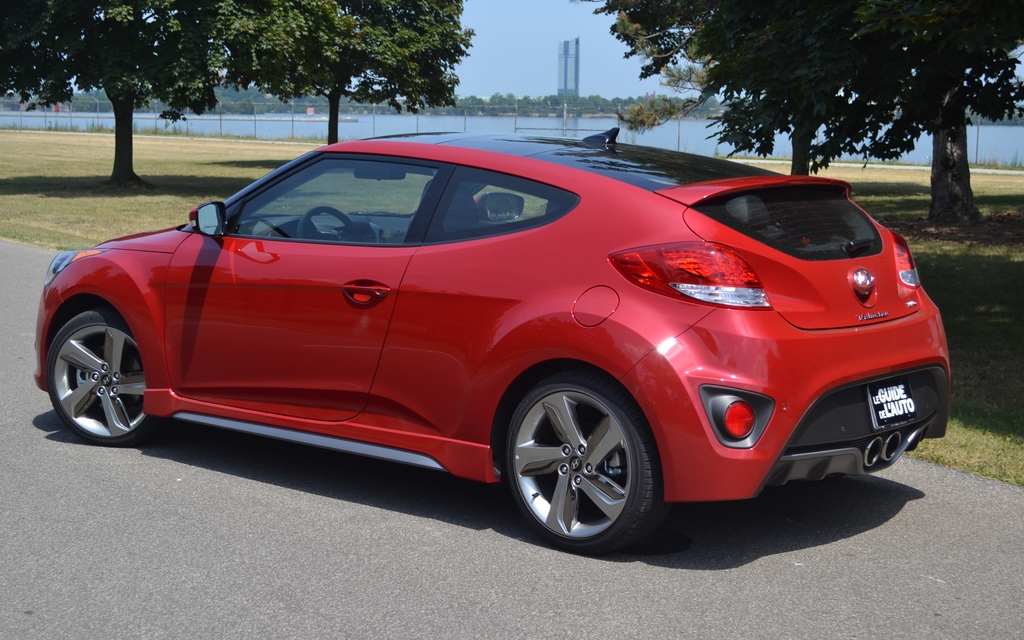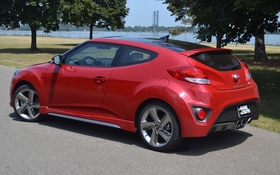2013 Hyundai Veloster Turbo: The engine it deserves

| Strong points |
|
|---|---|
| Weak points |
|
Introduced a year ago, people either love or hate the Hyundai Veloster – and a lot of people love it. Sales figures have surpassed manufacturer’s expectations and Canadian buyers are steadily snatching them up as they arrive in our country. Apparently, its unusual lines, superior equipment level and more-than-affordable price are a recipe for success, not only for its target market – young people – but for older people, too.
Although we were taken with many aspects of the car during its official launch, its performances left something to be desired. Its 1.6-litre 138-hp engine (originally featured in the Hyundai Accent) favours fuel economy, but it didn’t really seem to fit with the car’s aspirations. At the time, we said that the Veloster was an engine away from the being the perfect little sports car. The manufacturer reacted within a few short weeks by announcing the arrival of a version with a turbo engine. And that’s all it took to excite fans.
Performance upgrades
While it’s slowly rolling into dealerships, we recently had the chance to test drive this eagerly anticipated turbocharged version. What’s the verdict? This is the engine that should have been under the hood all along. First of all, the Veloster Turbo comes in only one version, which comes factory standard with all bells and whistles that equip the poshest version of the regular Veloster. That means it has the Tech Package and its navigation system with touch screen, back-up camera and high-end audio system. Add heated seats and a glut of other gadgets, and you get a car that offers a lot for the price – Hyundai’s signature.
Behind this Veloster’s improved performance, is a 1.6-litre turbocharged engine developing 201 horses and 195 lbs-ft of torque. This modern engine uses direct fuel injection technology, GDI, which improves performance and maintains fuel economy. This engine produces an exceptional 125-plus horses per litre, and is paired factory standard with a six-speed manual gearbox. And no, the regular Veloster’s optional dual-clutch six-speed automatic transmission is not an option, as it’s designed for fuel economy and not for high performance. There’s an optional conventional six-speed automatic gearbox too, but in our opinion, it isn’t really worth it.
More aggressive style
Style-wise, Hyundai truly embraced the idea of making this version more exclusive, and it’s hard not to notice it. In front, they removed the panel across the grille, thereby maximizing its size. In fact, it becomes the defining feature of the new front end. The rectangular fog lights have been replaced by new round pot lights on a grey background, giving the car more character.
The vehicle’s sides are aerodynamically styled and it comes factory standard with 18-inch rims. Too bad they decided to paint the interior of the spokes grey instead of the body colour as is the case with the ordinary version. The back is definitely the nicest part. In addition to the “Turbo” emblem on the hatch, an air diffuser was added under the bumper while the twin exhaust in the centre is round instead of rectangular. Finally, the rear reflectors got the same treatment as the fog lights in front. Basically, the Veloster Turbo has a much more extroverted appearance, and that’s good news for those who want to stand out. On the other hand, that’s bad news for buyers interested in the base version.
On board, the changes are much less pronounced. The Turbo version features the same passenger compartment, but there are two-tone leather sport seats with the word “Turbo” stitched onto the headrest. The rest is the same. We like the attention to detail and the materials seem to be much better quality than in the past. Hyundai did a good job on this.
Better handling
Once you start the car, you’ll notice that the engine sound is slightly richer thanks to the oversize exhaust. Of course, with its additional horsepower, the turbo engine gives the car more dynamic handling. Press the accelerator and this car responds quite a bit faster than the regular version. This engine really does the Veloster justice. In this version, performance and attitude go hand-in-hand, which is something that the original vehicle was lacking. The engine deploys power instantly to the front wheels, encouraged by a lighter twin-scroll turbocharger that limits inertia force.
Even with its 201 horses, the Veloster can’t be considered a true pocket rocket like the Ford Focus ST, Volkswagen GTI and Mazdaspeed3. Sure, the Turbo is more dynamic, but it’s not quite up to its competitors. Then again, the Veloster Turbo is more affordable at $25,990, compared to about $30,000 for the other cars.
Paired factory standard with the six-speed manual gearbox (the logical choice) the engine promotes a smooth, pleasant ride, and you feel like you have more than enough power for passing or to get up to speed when getting on to a road. But you often have to play with the stickshift to squeeze all the power out of the engine. While we were never really taken with Hyundai’s manual transmission, the Veloster goes a long way toward making things right. Although it isn’t as precise as some Japanese gearboxes, it’s a lot better than it used to be.
Not only does the Veloster Turbo have superior power, but the engineers also updated certain components to optimize performance. It comes with rack and pinion steering including faster gear reduction, which means more control in turns and a better feel for the road, while its ventilated front disc brakes are 20 mm bigger. Finally, its suspension integrates front and rear stabilizer bars, reducing weight transfers in turns. That’s what increases the fun of driving a car that was already a lot of fun to drive.
When you take into account its price, full equipment level and upgraded performance, it’s clear that the Veloster Turbo offers the best trade-off, especially compared to the regular version with the Tech Package. In our opinion, the choice is very simple: a very affordable base version with the naturally-aspirated engine, otherwise, better to go for the Veloster Turbo.











